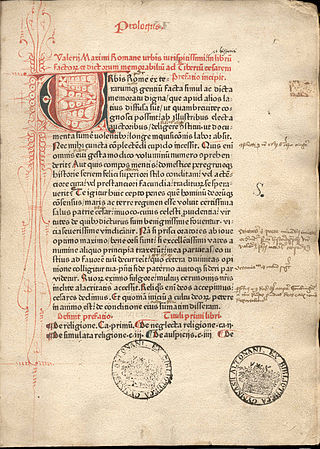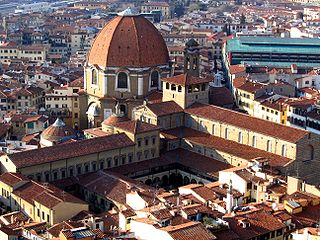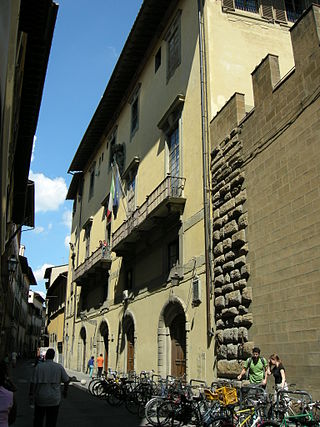
The Marucelliana Library or Biblioteca Marucelliana, is a public library, founded by the mid-18th century, and located on Via Camillo Cavour # 43, in Florence, region of Tuscany, Italy.

The Marucelliana Library or Biblioteca Marucelliana, is a public library, founded by the mid-18th century, and located on Via Camillo Cavour # 43, in Florence, region of Tuscany, Italy.
The library was opened to the public on September 18, 1752. It was willed by Abbot Francesco Marucelli, (died in Rome, 1703), as a library of general knowledge open to a wide audience, as indicated by the inscription on the facade: "Marucellorum Bibliotheca publicae maxime pauperum utilitati". The core of the collection derives from the library of Abbot Francesco.
Funded by the income of various abbeys, Francesco lived in Rome, where he was sometimes consulted as an expert in the Canon Law. His only publication, was a bibliographic compendium in fifteen volumes, Mare Magnum, of the contents of his library and or those of his acquaintance.
The building was commissioned by the grandson of the founder, Alessandro Marucelli (died 1751). Also a bibliophile himself, Alessandro expanded the entries in Mare Magnum to 24 volumes, and fulfilled his grandfather's will by selecting the site for the library on Via Condotti. He also donated his own books and appointed Angelo Maria Bandini as first librarian, a post he held for the fifty years. Alessandro died before the construction was complete. The original collection numbered about 6000 manuscripts, in all disciplines.
Bandini established the first alphabetic catalogues of the works, by author and by title. Mare Magnum was expanded to 111 volumes. Bandini concurrently served as the librarian for the Biblioteca Laurenziana in Florence. In 1776, the suppression of the Jesuits, brought their large collections into the library, consisting of more than one hundred and fifty works, including a dozen manuscripts. [ clarification needed ] In 1783, Bandini brought into the collection the drawings and prints of Francesco di Ruberto, and also those of the Marucelli family. He purchased the manuscript collection of Anton Francesco Gori, and obtained the library of the naturalist Antonio Cocchi and a portion of the library of the antiquarian Filippo Stosch.
The second librarian, Francesco Del Furia (1777-1856), held the post for the next fifty years. In the second half of the nineteenth century and the first of the next century by collections from the Martelli and Bonamici families and the correspondence of Nencioni, as well as many other documents and manuscripts. The 19th century suppressions of convents also enlarged their collections, including most of their sixteenth-century incunabula.
The late nineteenth-century English novelist George Gissing used the library on a number of occasions in early January 1889. [1]
In 1910, a law demanded that nearly all printed public works from Florence and nearby provinces also be deposited in the Marucelliana.
The edifice was built to house the library. A public contest to create the design had two main submissions, one by the Roman architect Alessandro Dori, and by the Florentine architect Giovanni Filippo Ciocchi. Dori had chosen Via Cavour as a main entrance, while Ciocchi chose a side street. A committee, which had access to the compelling wooden model, ultimately chose the less costly Dori model.
Construction (1747–1751) was directed by Dori; and by the late eighteenth century, space appeared tight. Currently, the complex has expanded beyond the original premises, into the adjacent Palaces Della Stufa and Pegna, and the ground floor of the Palazzo Fenzi Dardinelli.
The wooden model of the Library is on display, 104 cm high, 55 wide and 135 long. The model is detailed complete with the interior plans, including the Reading Room, as well as that of the access staircase.
The main reading room has a bust of Francesco Marucelli (1749) by Pietro Bracci and a plaster portrait of Giacomo Leopardi (1885) by Adriano Cecioni. A portrait of Francesco Marucelli has been attributed to Davide Canoniche.
At the base of the grand staircase there is a marble statue of Minerva, donated to the library by Giovanni Filippo Marucelli, bailiff of Malta. [2]
The library presently contains over a million volumes, including 490 incunabula and 7,995 cinquecentine, 2,927 manuscripts, and 69,345 personal letters and papers of interest. It contains nearly 53,000 etchings, and 3,200 drawings from the 16th-19th centuries, and 9,000 librettos of melodrammas, and numerous series of journals and newspapers. [3] Among its treasures are the papers of the anatomist Francesco Redi, the naturalist Giacinto Cestoni, and some of the letters of Antonio Vallisneri. The collection includes the "Luigi Beuf" Italian Cryptogamic Herbarium, with nearly 3000 independent samples of dried cryptogams.

In the history of printing, an incunable or incunabulum, is a book, pamphlet, or broadside that was printed in the earliest stages of printing in Europe, up to the year 1500. Incunabula were produced before the printing press became widespread on the continent and are distinct from manuscripts, which are documents written by hand. Some authorities include block books from the same time period as incunabula, whereas others limit the term to works printed using movable type.

Angelo Maria Bandini was an Italian author and librarian born in Florence.

The Laurentian Library is a historic library in Florence, Italy, containing more than 11,000 manuscripts and 4,500 early printed books. Built in a cloister of the Medicean Basilica di San Lorenzo di Firenze under the patronage of the Medici pope Clement VII, the library was built to emphasize that the Medici were no longer just merchants but members of intelligent and ecclesiastical society. It contains the manuscripts and books belonging to the private library of the Medici family. The library building is renowned for its architecture that was designed by Michelangelo and is an example of Mannerism.

The Marciana Library or Library of Saint Mark is a public library in Venice, Italy. It is one of the earliest surviving public libraries and repositories for manuscripts in Italy and holds one of the world's most significant collections of classical texts. It is named after St Mark, the patron saint of the city.

Bernardo Cennini was an Italian goldsmith, sculptor and early printer of Florence. As a sculptor he was among the assistants to Lorenzo Ghiberti in the long project producing the second pair of doors—the Doors of Paradise—for the Battistero di San Giovanni. He produced the first book printed at Florence. The painter and author of a famous book on the crafts, Cennino d'Andrea Cennini, was a member of the same Florentine family.

The Institución Colombina, situated in Seville, Spain, is the modern-day administrative branch that comprises the Biblioteca Capitular, the Biblioteca Colombina, the Cathedral Archives, Library of the Archbishopric and the General Archive of the Archbishopric. The Biblioteca Capitular and the Biblioteca Colombina are private libraries and are not supported financially by the Spanish government, but by the Fundación Cristóbal Colón and the Institución Colombina.

The Biblioteca Vallicelliana is a library in Rome, Italy. The library is located in the Oratorio dei Filippini complex built by Francesco Borromini in Piazza della Chiesa Nuova.

Benedetto Pamphili was an Italian cardinal, patron of the arts and librettist for many composers.

The Biblioteca Riccardiana is an Italian public library under the aegis of the Ministry of Culture, located inside the Palazzo Medici Riccardi at 10 Via de’ Ginori in Florence, in the neighborhood comprising the Mercato Centrale and the Basilica di San Lorenzo. Its main feature is preserving books collected by members of the Riccardi family and making them available in the very same rooms that were originally dedicated to that purpose. So, still today the library boasts the magnificent bookshelves, neatly carved and gilded, that create the atmosphere of a late-seventeenth-century patrician library, whose main features have all been kept intact.

The Biblioteca Palatina or Palatina Library was established in 1761 in the city of Parma by Philip Bourbon, Duke of Parma. It is one of the cultural institutions located in the Palazzo della Pilotta complex in the center of Parma. The Palatina Library was named after Apollus Palatinus.

Frederick Richmond Goff was an American rare book librarian and specialist in incunabula.

The Biblioteca Comunale degli Intronati is the public library located at Via della Sapienza #3 of the comune of Siena, in Tuscany, Italy.

The Biblioteca Nazionale Braidense or Braidense National Library, usually known as the Biblioteca di Brera, is a public library in Milan, in northern Italy. It is one of the largest libraries in Italy. Initially it contained large historical and scientific collections before it was charged with the legal deposit of all publications from Milan. Since 1880, it has had the status of a national library and is today one of the 47 Italian State libraries.

The Scarabelli library is the public library in the city of Caltanissetta in the centre of the island of Sicily, Italy. In 1862, the library was established by Antonio Mordini in the premises of the former Jesuit convent.

Giovanni Maria Ciocchi was an Italian painter and art critic, active during the Baroque period. He was born into a family of artists, and it is not clear if he is related to Giovanni Maria Ciocchi del Monte from Perugia, who became Pope Julius III. it is not clear that Giovanni Maria is related to the 16th century painter Ulisse Ciocchi.

The Casino Mediceo di San Marco is a late-Renaissance or Mannerist style palace located on Via Cavour number 57 and via San Gallo in Florence, region of Tuscany, Italy.

Francesco Marucelli was an Italian abbot, bibliographer and bibliophile. His book collections form the core of the Biblioteca Marucelliana in Florence.

The Biblioteca Comunale Mozzi Borgetti, founded in 1773, is the public library of Macerata, located on Piazza Vittorio Veneto 2 region of Marche, Italy. The name is sometimes hyphenated as Mozzi-Borgetti.
Francesco Strano was an Italian scholar, priest, and librarian, known for his extensive cataloguing of the large book collection, donated by Bishop Salvatore Ventimiglia to the University of Catania in Sicily.
Francesco Del Furia was an Italian scholar and librarian of the Biblioteca Marucelliana in Florence.